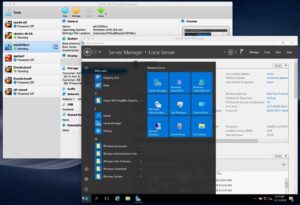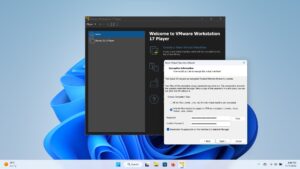The rise of Artificial Intelligence (AI) and Machine Learning (ML) has transformed industries across the globe, from natural language processing and computer vision to autonomous vehicles. At the heart of these advancements are optimized Linux distributions designed specifically to support the computational demands of AI workloads. As we move into 2025, several distributions have introduced cutting-edge features aimed at streamlining AI and ML development for researchers, developers, and enterprises. This article highlights the most notable AI-focused Linux distributions and what’s new for the year ahead.
1. Ubuntu AI: Streamlining AI Development
Canonical’s Ubuntu AI continues to be a popular choice for AI developers, offering a streamlined environment for building and deploying AI models.
Key Features:
- Preinstalled Frameworks: Ubuntu AI comes with popular AI frameworks such as TensorFlow, PyTorch, and Scikit-learn preinstalled, making it easier for developers to get started with their AI projects.
- GPU Support: Optimized for both NVIDIA CUDA and AMD ROCm, ensuring fast and efficient processing for deep learning tasks.
- Snap Packages: Ubuntu’s support for Snap packages makes installing and updating AI tools hassle-free.
- Enhanced Security: Containers are used to deploy AI models securely, ensuring isolated environments for better protection.
What’s New in 2025:
- Ubuntu AI Edge: A lightweight variant specifically designed for AI applications on IoT and mobile devices, providing flexibility for edge deployments.
- AI Workflow Automation: Integration with JupyterLab and MLflow allows for better management of machine learning pipelines.
- Real-Time Kernel Options: Improved real-time processing for use in robotics and autonomous systems, ensuring that tasks requiring low latency can be performed without delays.
2. Fedora AI: Cutting-Edge Tools for AI Professionals
Fedora AI is well-regarded for quickly adopting the latest technologies, making it a favorite among developers who want access to cutting-edge tools and libraries.
Key Features:
- Containerized AI: Thanks to Podman integration, Fedora provides isolated environments for AI development and deployment, improving workflow management.
- Latest Python Support: Fedora AI comes with Python 3.12 and AI libraries such as NumPy, Pandas, and Dask to help manage and analyze data.
- Wayland Optimization: Fedora’s optimization for Wayland ensures smoother graphical performance, which is crucial for visualization and model training.
What’s New in 2025:
- Open Neural Network Exchange (ONNX) Support: This allows for enhanced interoperability across AI frameworks, making it easier for developers to switch between different models.
- Quantum AI Toolkit: Fedora AI introduces tools for experimenting with quantum machine learning, opening new frontiers in AI research.
3. Pop!_OS AI: A Developer-Centric AI Platform
System76’s Pop!_OS is well-known for its performance, and the AI variant is no different, delivering a platform optimized for AI development.
Key Features:
- Intuitive Interface: The polished GNOME desktop environment makes it easy for developers to manage their AI projects without unnecessary complexity.
What’s New in 2025:
- Pop!_AI Cloud Sync: Seamless integration with Google Cloud Platform (GCP) and AWS for scalable AI workloads, simplifying cloud deployments.
- LLM Optimization: Enhancements to speed up the fine-tuning and inferencing of large language models (LLMs), ensuring faster and more efficient training.
- Tensor Cores Utilization: Improved support for NVIDIA Tensor Cores, which are crucial for accelerating AI workloads on GPUs.
4. Red Hat Enterprise Linux (RHEL) AI: Enterprise-Grade Stability
RHEL AI is designed for businesses that require the stability and security needed for mission-critical AI workloads.
Key Features:
- Scalability: RHEL AI is optimized for both small-scale and large-scale AI projects, providing the flexibility enterprises need to scale.
- Certified Hardware: Broad compatibility with enterprise-grade systems, ensuring reliable performance for heavy AI tasks.
What’s New in 2025:
- AI Application Catalog: Red Hat now offers a catalog of Red Hat-certified AI applications and frameworks, ensuring compatibility and reliability.
- Federated Learning Tools: New support for decentralized model training, enabling better privacy safeguards and compliance with data protection regulations.
- OpenShift Integration: Simplifies the deployment of AI models in cloud-native infrastructures using OpenShift, making it easier to scale AI models.
5. Arch Linux AI: Maximum Customizability
Arch Linux AI offers complete control over your environment, ideal for advanced users who want to build an AI system tailored specifically to their needs.
Key Features:
- Rolling Release: Arch Linux offers constant updates, ensuring that you always have access to the latest AI tools and libraries.
- Arch User Repository (AUR) Access: Access to a vast, community-driven software repository, giving developers flexibility in their choice of tools.
- Minimal Base Install: Arch allows users to customize their system from the ground up, which is perfect for specific AI projects.
What’s New in 2025:
- AI Environment Builder: This tool automates the setup of popular AI frameworks, making it easier for users to get started with deep learning.
- ONNX Runtime Boost: Arch Linux AI is optimized to improve ONNX model performance, which helps streamline the deployment of AI models trained with ONNX.
- Benchmarking Tool: A utility that allows users to compare deep learning framework performance on their hardware.
6. Deep Learning AMI (Amazon Linux): Cloud-Ready AI Development
Amazon’s Deep Learning AMI is optimized for developing and deploying AI models on AWS, providing a cloud-native solution for large-scale AI workloads.
Key Features:
- AWS Tools: Preloaded with essential AWS tools like AWS CLI, Boto3, and SageMaker SDK, facilitating seamless integration with AWS services.
- GPU Acceleration: Full support for CUDA and cuDNN, enabling faster processing on NVIDIA GPUs.
- Integrated Frameworks: TensorFlow, PyTorch, and MXNet come preinstalled, making it easy to get started with AI development on AWS.
What’s New in 2025:
- Graviton AI Optimizations: Enhanced optimizations for ARM-based Graviton processors, which are becoming more popular in AI workloads due to their cost-effectiveness and performance.
- SageMaker Integration: Deep learning AMI now offers better integration with SageMaker, making AI model training and deployment more efficient.
- Edge Deployment Tools: New tools to deploy AI models to AWS IoT-connected edge devices, enabling AI at the edge.
Choosing the Right AI-Focused Linux Distribution
When selecting a Linux distribution for AI and ML workloads, here are some key considerations:
- Hardware Compatibility: Ensure your chosen distribution supports GPUs, TPUs, and other accelerators.
- Ease of Use: Some distributions are more beginner-friendly, while others cater to advanced users.
- Pre-Installed Tools: Look for distros that come with the frameworks and libraries you need.
- Scalability: Ensure your distro supports clustering and cloud-native deployments, especially if you plan to run large models.
The Road Ahead for AI-Optimized Linux Distributions
As we look toward the future of AI-optimized Linux distributions, several key trends are expected to shape the landscape in 2025 and beyond:
- Expanded LLM Support: Further optimizations for handling massive datasets and pre-trained models.
- Edge AI Advancements: Continued development of lightweight options for deploying AI on edge devices.
- Quantum Integration: Support for emerging quantum machine learning tools, pushing the boundaries of AI research.
- Sustainability: The development of energy-efficient AI frameworks to reduce the environmental impact of AI training processes.
Conclusion
In 2025, Linux distributions tailored for AI and ML workloads are more essential than ever. Whether you are a researcher, developer, or enterprise, there’s a wide variety of options available to suit every need—from cloud-based solutions to lightweight edge deployments. These specialized distros provide the infrastructure and tools necessary to drive innovation in AI, making it easier than ever to develop, scale, and deploy AI models across various platforms.












